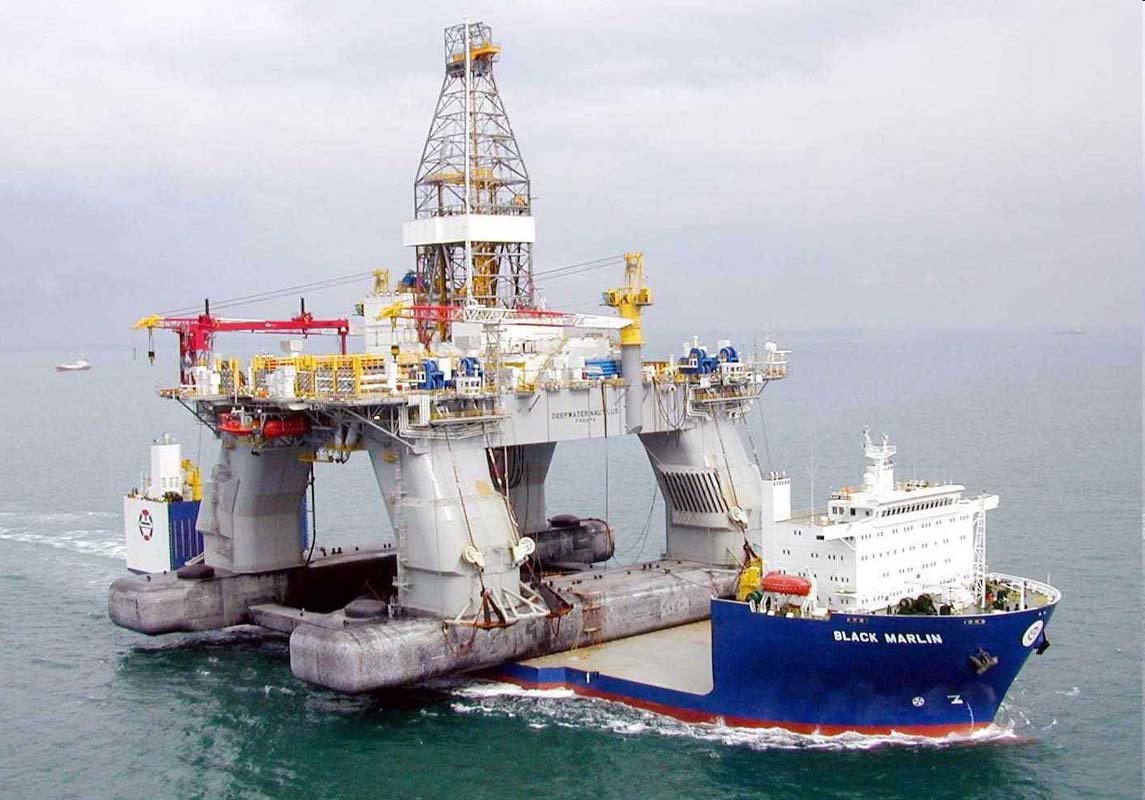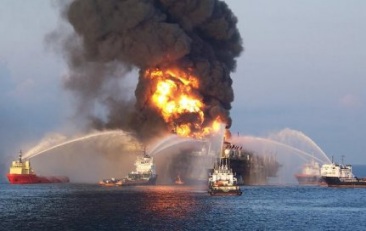Gulf of Mexico oil drilling platforms.
 The yellow dots mark the location of the approximately
4000 oil well drilling platforms in the Gulf of Mexico. They are interconnected by
25,000 miles of pipes. Some of the platforms
stand on stilts, some float but are anchored in place and some float freely.
Note that none are near Florida. This is because Florida has decided
that oil drilling is too much of risk to the tourist industry.
The yellow dots mark the location of the approximately
4000 oil well drilling platforms in the Gulf of Mexico. They are interconnected by
25,000 miles of pipes. Some of the platforms
stand on stilts, some float but are anchored in place and some float freely.
Note that none are near Florida. This is because Florida has decided
that oil drilling is too much of risk to the tourist industry.
The Deepwater Horizon floating oil rig
The Macondo Prospect reservoir contains billions of
dollars worth of oil. All you need is a 3 mile straw
to tap it. The
Deepwater Horizon floating oilrig was designed to insert
the straw. It is owned by Transocean and leased
to BP. It was built
in South Korea in 2001 and it is state of the art in
every way. It dynamically positions itself by means
of satellites. It is not anchored to the sea floor.
It actively resists winds and currents by means of
propellers. It can also compensate for tides and wave
action.
Its replacement cost is about one billion dollars. It
is now on the sea bottom not far from the oil well it
drilled.
The Deepwater Horizon has propellers and it can move
on its own at speeds up to 4 knots. However, long sea
voyages are out of the question. To get from North
Korea to the Gulf of Mexico, the Deepwater Horizon
would have to go around either South American or
Africa, which is a long and difficult sea voyage in
either case. The
Black Marlin was designed to transport
large things. Here is the Black Marlin transporting
the Deepwater Horizon;

You get to play with very large toys in the oil industry.
Some calculations before drilling the Macondo Prospect
We have seen how Achimedes principle leads to an understanding of how an oil reservoir forms in nature. Now let us try to understand what happens when we put the straw in the oil and gas reservoir known as the Macondo Prospect. It is beneath 5000 feet of water plus 13,000 feet of rock. In metric units the numbers are 1524 meters and 3962 meters, respectively.
What is the oil reservoir pressure?
Before we calculate the pressure, we have to decide
what unit of pressure to use. There are several
choices. I propose the bar, which is atmospheric
pressure. It is a familiar and intuitive. For
example; automobile tires are inflated to about two
bars. You will experience one bar of extra pressure
if you dive 10 meters or 34 feet into water. It turns
out to be true, within 1 percent, that the water
pressure under 10 meters of water is one bar. Or,
equivalently, the pressure due to the weight of the
water is one kilogram per square centimeter. The
computation of pressure in bars becomes easy. You
divide the depth in meters by 10. This only works for
water which has a specific gravity (SP) of one, by
definition.
So, the pressure, at the well head, at the bottom of
the sea, over the Macondo Prospect, is 152 bars. The
oil reservoir is beneath 3962 meters of rock. The
specific gravity of rock is typically 2.5 and this
extra weight increases the pressure. The pressure
within the reservoir, due to 3962 meters of rock,
is;
3962 * 2.5 / 10 = 990 bars.
The total pressure in the reservoir is 152 + 990 =
1142 bars. To get psi (pounds per square inch) you
multiply by 14.7. That would be 16,800 psi. The most
serious
power washer I can find works at 5,000 psi.
However, the straw leading to the surface would never
be filled with air. At various times, the straw would
be filled with drilling mud, water or crude oil. We
would like to know how much pressure to expect at the
surface. To do this, the weight of the fluid would be
subtracted from the reservoir pressure. The light
sweet oil found in the Macondo Prospect has a
specific gravity of 0.85. So the pressure at the
bottom of the well due to the weight of the oil
is;
0.85 * ( 1524 + 3962 ) / 10 = 466 bars.
So, at the surface, with oil in the straw, the
pressure would be 1142 - 466 = 676 bars. The methane
always found dissolved in the oil causes complications
which will be ignored for now.
A deep water oil well is complex. The production
pipe, at the very bottom of the well is 7 inches 18
centimeters in diameter. The pipe at the ocean floor
is 36 inches in diameter. In between, there are
several different sizes, as this picture illustrates.
To keep things simple, let's assume the pipe is 18
centimeters top to bottom. Let's calculate the force
of the oil coming up the 18 centimeter pipe at the
ocean's surface. That would be the cross section of
the pipe times the pressure, or;
9 * 9 * pi * 676 = 172,000 kilograms or 378,000
pounds.
That is enough force to lift 6, fully loaded dump
trucks straight up.

Properties of methane.
Methane is a gas at ordinary temperatures and pressures.
The gas that cooks your food and heats
your house is mostly methane. But methane is a liquid
at the pressures found within the Macondo reservoir.
Methane as a liquid is miscible with crude oil. If
you mix olive oil and canola oil you will see what
miscible means. They don't separate the way a water
and oil mixture would.
The methane in the Macondo reservoir becomes a gas if
the pressure is reduced. At sea level, the volume of
the gas is 600 times greater than the original
liquid. Methane's conversion from liquid to gas
happens fast when the pressure goes below 100 bars.
This has implications when methane goes up the
straw.
 Methane and water does something
unusual at high pressure. They form methane hydrate
which is essentially little balls of ice enclosing
methane molecules as the picture illustrates. Methane
hydrate is a somewhat stable solid at atmospheric
pressure, but it can suddenly decompose in pipes
leading to pressure surges. Methane hydrate is the
stuff that stopped BP's early attempt to cap the
blowout preventer.
Methane and water does something
unusual at high pressure. They form methane hydrate
which is essentially little balls of ice enclosing
methane molecules as the picture illustrates. Methane
hydrate is a somewhat stable solid at atmospheric
pressure, but it can suddenly decompose in pipes
leading to pressure surges. Methane hydrate is the
stuff that stopped BP's early attempt to cap the
blowout preventer.
The science behind a blowout
Let's do some calculations. BP says they collected
15,000 barrels of oil and flared 30 million cubic
feet of natural gas on 9 June. That works out to be
2000 cubic feet of methane per barrel. There must
have been 3.33 cubic feet of liquid methane
accompanying each barrel of oil before expansion by a
factor of 600. Let's take that as representative of
Macondo oil.
A barrel of oil is 5.61 cubic feet. Macondo prospect
oil looses 37 percent of its volume when it reaches
sea level because the methane that was dissolved in it
escapes as a gas.
Let's presume 36,000 barrels per day are going up a
20 inch pipe. That flow rate is in the middle of the
range of estimates in mid June. That is 1,500 barrels
or 8,415 cubic feet per hour. A length of 20 inch pipe 0.46
feet long will hold a cubic foot of oil. Multiply
that by the number of cubic feet the pipe must move
in an hour. That is 3857 feet per hour or about 0.73
miles per hour at the sea floor. Now let's figure out
how fast the methane is moving. The pipe must carry
1,500 times 2000 cubic feet of gas per hour. Multiply
that by 0.46 and you get 1,375,000 feet per hour.
Divide that by the number of feet in a mile (5280) to
get 260 miles per hour. The oil is carried as a mist
of droplets in the methane hurricane. "Blowout" is an
apt description.
A blowout is what happens when you lose control of an oilwell.
